Archives
br Conclusions In the current study we found
Conclusions
In the current study, we found that the exposure of maduramicin to chicken myocardial Sennoside A results in cellular damage and even death via the induction of apoptosis. Maduramicin upregulated the expression of apoptotic genes and activated caspase cascades, which were accompanied by an elevation of intracellular Ca2+ and ROS levels and a decrease in GSH and MMP levels, thereby ultimately inducing cell apoptosis. The elevated cytoplasmic Ca2+ levels was due to an influx from the extracellular medium and its release from the endoplasmic reticulum. z-VAD-fmk significantly ameliorated maduramicin induced apoptosis and cytotoxicity in chicken myocardial cells. However, NAC did not mitigate the maduramicin-induced apoptosis and cytotoxicity in chicken myocardial cells. Taken together, these findings indicate that caspase-dependent and independent apoptotic pathways mediate maduramicin-induced cardiotoxicity.
Conflict of interest
Acknowledgment
The authors thank Shile Huang from Department of Biochemistry and Molecular Biology, Louisiana State University Health Sciences Center, for critical reading and editing of the manuscript. We also thank LetPub (www. Letpub. com) for its linguistic assistance during the preparation of this manuscript. This work was supported by grants from the National Natural Science Foundation of China (31672612,  31502120), the China Postdoctoral Science Foundation Funded Project (2016T9047) and a Project Funded by the Priority Academic Program Development of Jiangsu Higher Education Institutions (PAPD).
31502120), the China Postdoctoral Science Foundation Funded Project (2016T9047) and a Project Funded by the Priority Academic Program Development of Jiangsu Higher Education Institutions (PAPD).
Introduction
Ewing Sarcomas (ES) are rare, aggressive childhood cancers thought to arise from mesenchymal stem cells of bone and soft tissues [1], [2], [3]. This family of cancers arises due to a balanced chromosomal translocation of the EWS gene and a member of the ETS family of genes, most commonly friend leukemia virus integration 1 (FLI1) [1], [4]. Five-year survival rates are 60–70% for children with localized disease, and these rates fall to 30% for children afflicted with metastatic spread [1], [4]. Multimodal treatment is the standard of care, encompassing systemic chemotherapy in combination with radiation or surgery [4]. Together, these findings highlight the need to identify novel biologic strategies for the treatment of this disease.
Epithelial-to-mesenchymal transition (EMT) is a dynamic developmental process that is exploited in carcinoma progression to mediate invasion, metastasis, and therapeutic resistance [5], [6]. Loss of E-cadherin expression is considered the hallmark event of EMT [7]. We have previously conducted a phenot ypic screen of 83,200 compounds to identify small molecules capable of inducing the re-expression of E-cadherin expression in colon and lung carcinoma cell lines [8]. Chemical optimization of our initial “hit” yielded a chemical probe, ML327 (N-(3-(2-hydroxynicotinamido) propyl)-5-phenylisoxazole-3-carboxamide), that partially reverses EMT in advanced epithelial cancers [9]. ML327 does not alter the cellular viability of colon and lung cancer cells, but is capable of blocking carcinoma cell invasiveness in vivo[10]. Intriguingly, we have recently reported that induction of partial mesenchymal-to-epithelial transition (MET) in neural crest-derived neuroblastomas blocks growth both in vitro and in vivo by inducing cell cycle arrest and necrosis, highlighting the therapeutic potential of this small molecule in cancers of non-epithelial origin [11].
Lack of progress in the treatment of children with ES has led to investigations into the efficacy of TNF-related apoptosis-inducing ligand (TRAIL) [12], [13]. TRAIL is a pro-apoptotic cytokine of the TNF superfamily with appealing therapeutic potential given its ability to selectively induce apoptosis in cancer cells with minimal toxicity [14]. The majority of ES cell lines are sensitive to TRAIL in vitro[12]. TRAIL-based strategies have also been shown to block tumor growth and osteolysis and increase survival in in vivo ES models [15], [16]. Resistance to TRAIL has been linked to acquisition of migratory mesenchymal characteristics and upregulation of anti-apoptotic proteins, including cellular FLICE-like inhibitory protein (cFLIP) [14].
ypic screen of 83,200 compounds to identify small molecules capable of inducing the re-expression of E-cadherin expression in colon and lung carcinoma cell lines [8]. Chemical optimization of our initial “hit” yielded a chemical probe, ML327 (N-(3-(2-hydroxynicotinamido) propyl)-5-phenylisoxazole-3-carboxamide), that partially reverses EMT in advanced epithelial cancers [9]. ML327 does not alter the cellular viability of colon and lung cancer cells, but is capable of blocking carcinoma cell invasiveness in vivo[10]. Intriguingly, we have recently reported that induction of partial mesenchymal-to-epithelial transition (MET) in neural crest-derived neuroblastomas blocks growth both in vitro and in vivo by inducing cell cycle arrest and necrosis, highlighting the therapeutic potential of this small molecule in cancers of non-epithelial origin [11].
Lack of progress in the treatment of children with ES has led to investigations into the efficacy of TNF-related apoptosis-inducing ligand (TRAIL) [12], [13]. TRAIL is a pro-apoptotic cytokine of the TNF superfamily with appealing therapeutic potential given its ability to selectively induce apoptosis in cancer cells with minimal toxicity [14]. The majority of ES cell lines are sensitive to TRAIL in vitro[12]. TRAIL-based strategies have also been shown to block tumor growth and osteolysis and increase survival in in vivo ES models [15], [16]. Resistance to TRAIL has been linked to acquisition of migratory mesenchymal characteristics and upregulation of anti-apoptotic proteins, including cellular FLICE-like inhibitory protein (cFLIP) [14].